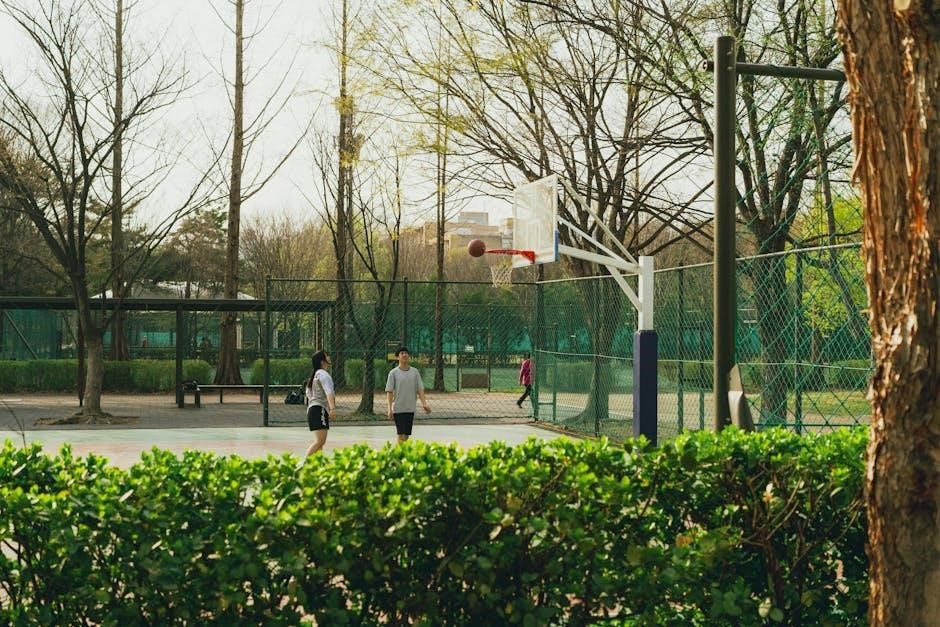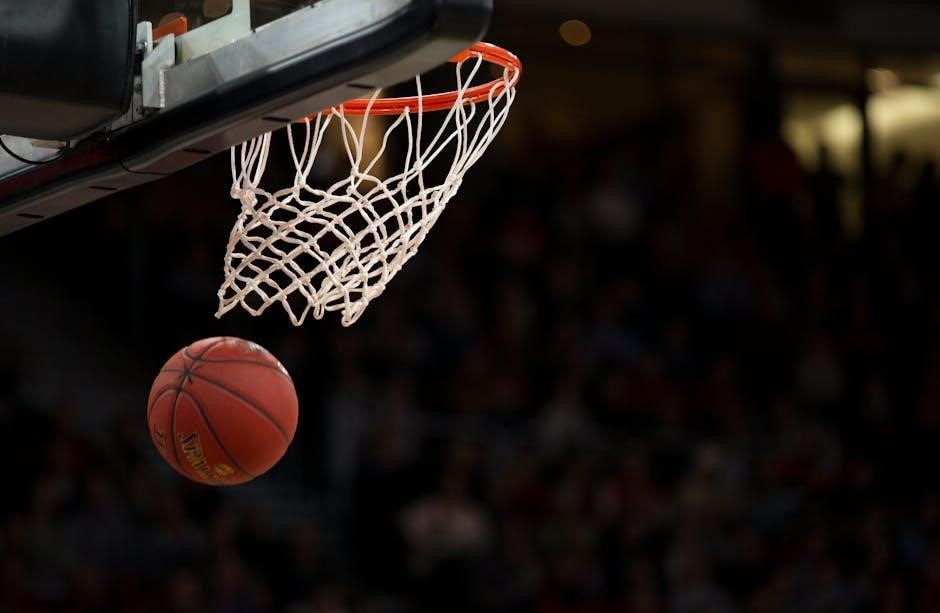10 Basic Rules of Basketball
Basketball involves two teams competing to score by shooting a ball through a hoop. Each team consists of five players on the court. Dribbling is essential for moving the ball, while passing facilitates teamwork. Fouls result in free throws, and violations lead to turnovers.
Objective of the Game
The primary objective in basketball is elegantly simple: to outscore the opposing team. This is achieved by successfully shooting the basketball through the opponent’s hoop, which is elevated ten feet above the ground. Each successful shot, known as a field goal, awards points to the scoring team. The number of points awarded depends on the location from which the shot is taken; shots made from inside the three-point arc are worth two points, while shots made from beyond the arc are worth three points.

Beyond merely scoring points, the objective also involves preventing the opposing team from scoring. This is accomplished through defensive strategies such as guarding opponents, intercepting passes, and blocking shots. Rebounding, the act of securing the ball after a missed shot, is also crucial for both offensive and defensive purposes, providing second-chance opportunities for scoring and preventing the opponent from doing the same.
Ultimately, the team with the most points at the end of the game is declared the winner; However, the beauty of basketball lies not only in the final score but also in the strategic interplay, teamwork, and individual skill displayed throughout the contest. It’s a dynamic blend of offense and defense, requiring both physical prowess and mental acuity.

Number of Players
A standard basketball game features two teams, each composed of five players on the court simultaneously. This configuration allows for a dynamic balance between offensive and defensive strategies, fostering teamwork and individual contributions. While five players constitute the active roster during gameplay, teams typically maintain a larger squad of players available for substitution.

Substitutions are a crucial element of basketball, enabling coaches to strategically manage player fatigue, address foul trouble, and adapt to the flow of the game. There’s a maximum number of players on the court at any given time. The coach is in charge of substituting players.
Although five players represent the standard, variations exist, particularly in informal settings. Games can be adapted to accommodate different numbers of participants, ensuring inclusivity and enjoyment. For instance, “three-on-three” basketball is a popular alternative, emphasizing individual skill and court awareness in a more condensed format. Regardless of the specific format, maintaining a balanced number of players on each side is essential for fair competition and strategic gameplay. A team must have a minimum of four players to start a game.
The Court
The basketball court, a rectangular playing surface, serves as the arena for the game’s dynamic action. It features two hoops positioned at opposite ends, acting as the targets for scoring. A key element is the division of the court into two halves. This division is fundamental for establishing offensive and defensive territories.
Key markings define specific areas, influencing player movement and strategic plays. The free-throw lanes, painted areas extending from the free-throw line to the baseline, dictate positioning during free-throw attempts. Furthermore, the three-point line, an arc extending from each basket, designates the area from which successful shots earn three points, adding a layer of complexity to offensive strategies.
Understanding the court’s dimensions and markings is crucial for players. It is also important for officials. Familiarity with these elements allows for informed decision-making, strategic positioning, and effective execution of plays. From the baseline to the half-court line, every aspect of the court contributes to the game’s dynamic flow.
Scoring
In basketball, accumulating points is the primary objective, determining the victor of the contest. Points are awarded based on the success of shooting the ball through the hoop, with varying values assigned depending on the location of the shot. A field goal, executed from within the three-point line, earns a team two points, contributing to their overall score.
Elevating the scoring stakes, a successful shot launched from beyond the three-point arc grants a team three points, providing an incentive for long-range accuracy. Free throws, awarded following fouls committed by the opposing team, offer a single point each, presenting opportunities to convert fouls into scoring advantages. The team that amasses the highest total of points by the culmination of the game’s duration is declared the winner, underscoring the significance of efficient and strategic point accumulation.
The interplay between two-point field goals, three-point shots, and free throws shapes offensive strategies. Efficient scoring from various locations is crucial for securing victory. Teams must strategically balance inside plays with perimeter shooting to maximize their scoring potential and outmaneuver their opponents.
Starting the Game
The commencement of a basketball game is marked by a jump ball, a pivotal moment that determines initial possession. The referee initiates this process by tossing the ball vertically between two opposing players positioned at the center circle. These players leap into the air, each vying to tap the ball towards their respective teammates, initiating the first offensive play of the game. The team that successfully gains control of the ball after the jump ball assumes possession and begins their offensive efforts.
Following the jump ball, possession alternates between teams at the start of subsequent periods, ensuring fairness and equal opportunity; This alternating possession rule maintains a balanced competitive environment, preventing one team from consistently dominating the game’s opening moments. Understanding the jump ball procedure and the alternating possession rule is fundamental to grasping the game’s structure and the dynamics of initial play.
The jump ball signifies the beginning of the game, setting the stage for strategic plays and intense competition. Teams prepare specific plays to capitalize on initial possession, aiming to establish an early lead and set the tone for the remainder of the match;
Dribbling
Dribbling is a fundamental skill in basketball, enabling players to move the ball across the court while maintaining possession. It involves bouncing the ball continuously with one hand while walking or running. Players must dribble to advance the ball unless they are passing or shooting. Mastering dribbling techniques is crucial for ball control, agility, and creating offensive opportunities.
There are several key aspects to effective dribbling. Players should keep their head up to maintain awareness of their surroundings, including teammates, opponents, and the court. Using fingertips rather than the palm provides better control of the ball. Varying dribbling speed and height can help players evade defenders and create space. Protecting the ball by keeping the body between the ball and the defender is also essential.
Players must adhere to certain rules while dribbling. A player cannot stop dribbling and then start dribbling again (double dribble). They also cannot carry the ball by holding it in their hand while moving (carrying). Violations result in a turnover, giving possession to the opposing team. Skilled dribbling is essential for effective offense and is a cornerstone of basketball proficiency.
Passing
Passing is a crucial element of basketball, enabling teamwork and efficient ball movement. It involves throwing the ball to a teammate, allowing the offense to advance the ball and create scoring opportunities. Effective passing requires accuracy, timing, and awareness of teammates’ positions and movements. Different types of passes are used depending on the situation and distance.
The chest pass is a common and reliable technique, involving pushing the ball from the chest towards a teammate’s chest. The bounce pass is another valuable option, bouncing the ball off the floor so it reaches the receiver at waist level. Overhead passes are useful for longer distances, throwing the ball from above the head. Players must also learn to make quick decisions about which pass to use and when to pass the ball.
Good passing skills contribute significantly to offensive success. Accurate passes create open shots and allow for faster transitions. Effective passing involves communication, anticipating teammates’ movements, and making smart decisions under pressure. Teams that prioritize passing often have a more fluid and dynamic offense, making them harder to defend. Passing is an essential skill for all basketball players, regardless of their position.
Fouls
In basketball, a foul occurs when a player commits an illegal action that involves contact with an opponent or violates the rules of the game. Fouls are a common occurrence and can significantly impact the flow and outcome of a game. Players must be aware of the different types of fouls and how they are penalized.
Personal fouls are the most frequent type, typically involving illegal contact such as pushing, holding, or tripping. When a player commits a personal foul, the opposing team may be awarded free throws, or possession of the ball, depending on the situation. After accumulating a certain number of personal fouls, a player is removed from the game.
Technical fouls are another category, arising from unsportsmanlike conduct, such as arguing with officials or using inappropriate language. Technical fouls result in the opposing team receiving free throws and possession of the ball. Flagrant fouls involve excessive or violent contact and carry more severe penalties, potentially leading to ejection from the game.
Understanding the rules regarding fouls is essential for players to avoid penalties and maintain fair play. Controlling emotions and avoiding unnecessary contact is crucial for minimizing fouls and contributing positively to the team’s performance.
Free Throws
Free throws in basketball represent an unguarded shot at the basket from behind the free-throw line. They are awarded to a player after being fouled while in the act of shooting or when the opposing team accumulates a certain number of fouls in a period. Each successful free throw is worth one point, making them a crucial opportunity to score.
When a player is awarded free throws, they must take the shot within a specified time limit, typically five seconds, without crossing the free-throw line until the ball hits the rim. Other players line up along the free-throw lane, adhering to specific positioning rules, and can rebound the ball if the shot is missed;
Free-throw shooting is a fundamental skill in basketball, requiring precision, focus, and consistency. Players often develop their own routines to maintain composure and maximize their chances of success. Effective free-throw shooting can significantly impact the outcome of a game, especially in close contests where every point matters.
Mastering the art of free throws involves consistent practice, proper technique, and mental fortitude. Players who excel at free throws become valuable assets to their teams, providing a reliable source of points and contributing to overall success.

Violations
In basketball, violations are infractions of the rules that result in a turnover of possession to the opposing team. Unlike fouls, violations do not involve illegal contact with an opponent. Instead, they typically involve procedural errors or breaches of specific regulations governing player movement and ball handling. Common examples of violations include traveling, double dribble, and going out of bounds.
Traveling occurs when a player moves their pivot foot illegally while holding the ball. Double dribble happens when a player dribbles the ball with both hands simultaneously or stops dribbling and then starts again. A player is called for going out of bounds when they cause the ball to go outside the boundary lines of the court.
Other violations include three-second rule violations, where an offensive player remains in the free-throw lane for more than three consecutive seconds, and backcourt violations, where a team brings the ball back into their own backcourt after crossing the half-court line. These violations aim to maintain fair play and prevent teams from gaining an unfair advantage.
Understanding and avoiding violations are essential for successful basketball play. Players must be aware of the rules and practice proper techniques to minimize turnovers and maintain possession of the ball.
Out of Bounds
In basketball, the term “out of bounds” refers to the area outside the boundary lines of the court. These lines demarcate the playing area, and any part of the ball or a player’s body that touches the floor outside these lines is considered out of bounds. Determining when the ball or a player is out of bounds is a crucial aspect of officiating and gameplay.
The ball is ruled out of bounds when it touches any part of the boundary lines, the floor outside the lines, or any object or person outside the lines. Similarly, a player is out of bounds when they touch the floor outside the boundary lines. When the ball goes out of bounds, possession is awarded to the opposing team at the point where the ball exited the court.
The last player to touch the ball before it goes out of bounds is typically considered responsible for the ball leaving the playing area. However, if the ball deflects off a player and then goes out of bounds, the last player to touch it may not necessarily be the one at fault. Officials must carefully observe the play to make the correct call.
Understanding the out-of-bounds rule is essential for players and coaches, as it can significantly impact possession and scoring opportunities during a game.
Traveling
Traveling in basketball is a violation that occurs when a player with possession of the ball moves their feet illegally. The fundamental principle is that a player can only move one foot, known as the pivot foot, while maintaining contact with the floor once they have established possession and stopped moving. Lifting the pivot foot before dribbling, passing, or shooting constitutes traveling.
The rules surrounding traveling can be complex, but the basic premise is to prevent players from gaining an unfair advantage by moving without dribbling. After receiving the ball, a player can establish a pivot foot by either stepping with one foot while the other remains planted or by jumping to a stop on both feet simultaneously. If a player jumps to a stop, neither foot can be lifted before releasing the ball.
There are specific exceptions and nuances to the traveling rule. For example, a player can take steps during a jump shot as part of the shooting motion. However, they must release the ball before either foot returns to the floor. Similarly, a player who is dribbling can stop and then take two steps to come to a controlled halt.

Officials closely monitor players’ footwork to ensure compliance with the traveling rule, and violations can result in a turnover, giving possession to the opposing team.
Double Dribble
A double dribble in basketball is a violation that occurs when a player dribbles the ball with both hands simultaneously or stops dribbling and then starts dribbling again. The rule is designed to prevent players from gaining an unfair advantage by controlling the ball excessively without advancing it toward the basket.
Once a player establishes a dribble, they must continue dribbling with one hand at a time. Using both hands to dribble at the same time results in an immediate double dribble violation. Similarly, if a player stops dribbling, they cannot resume dribbling again. They must either pass the ball, shoot it, or hold it while keeping one foot planted as their pivot foot.

The double dribble rule is strictly enforced by officials, and violations result in a turnover, giving possession of the ball to the opposing team. The purpose of the rule is to encourage continuous movement and prevent players from stalling or excessively controlling the ball without making progress toward the basket.
Understanding and adhering to the double dribble rule is essential for all basketball players to avoid unnecessary turnovers and maintain the flow of the game;

Goaltending
Goaltending in basketball is a violation that occurs when a player interferes with a shot while it is on its downward trajectory towards the basket, or when it is in the cylinder directly above the rim. This rule is designed to prevent defensive players from unfairly blocking or interfering with a shot that has a legitimate chance of going in.
Once a shot is released by an offensive player and is on its way down towards the basket, defensive players are prohibited from touching the ball until it either enters the basket or hits the rim. Similarly, if the ball is in the imaginary cylinder directly above the rim, defensive players cannot reach up and block or deflect the shot.
If a defensive player commits goaltending, the offensive team is awarded the points as if the shot had been made successfully. The ball is then awarded to the offensive team for possession. Goaltending is strictly enforced by officials, and violations can significantly impact the outcome of a game.
Understanding the goaltending rule is essential for both offensive and defensive players. Offensive players need to be aware of the protections afforded to their shots, while defensive players must avoid interfering with shots that are on their way down or within the cylinder above the rim.
Timeouts
Timeouts are a crucial strategic element in basketball, allowing teams to pause the game for a brief period. These breaks provide opportunities to discuss strategy, make substitutions, and regroup, potentially shifting the momentum of the game. Each team is typically granted a limited number of timeouts per half or per game, depending on the specific rules in place.

During a timeout, the game clock stops, and players gather with their coaches to review plays, address weaknesses, and make necessary adjustments. Coaches use this time to provide feedback, offer encouragement, and implement new tactics to counter the opposing team’s strategies. Timeouts are also valuable for managing player fatigue, especially during critical moments in the game.

Teams can call timeouts when the ball is dead or when their team has possession of the ball. The length of a timeout can vary, but it is usually around one minute. Strategic use of timeouts can be a game-changer, allowing teams to regain composure, disrupt the opponent’s rhythm, and ultimately increase their chances of success.
Effective timeout management is a key skill for coaches, as the right timeout at the right moment can turn the tide of a game. Timeouts are more than just breaks; they are opportunities for strategic intervention and adjustments.


